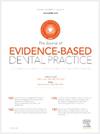在低骨密度部位,比较骨密度化与传统钻孔技术对种植体稳定性和骨密度的影响:一项系统综述和荟萃分析
IF 4
4区 医学
Q1 DENTISTRY, ORAL SURGERY & MEDICINE
引用次数: 0
摘要
目的探讨低骨密度部位骨增密技术(OD)对种植体稳定性和骨密度的影响。材料与方法采用电子检索和手工检索两种方法,分析了OD与CD技术对种植体稳定性和骨密度的影响,包括基于人的随机对照试验(rct)和非随机对照试验(NRCTs)。分别使用rct和nrct的(rob2.0)和(ROBINS-I)工具评估偏倚风险。meta分析采用RevMan 5.4软件,采用随机固定效应模型。异质性采用Q检验评估,I2统计量量化。结果共检索到1454篇文献,其中只有6篇符合全部纳入标准。纳入研究的荟萃分析显示,OD组种植体稳定商(ISQ)高于CD组,但在种植体放置后立即和随访期间均无统计学意义,标准化平均差异为2.13 [95%CI = −0.08,4.35],P = 。[95%CI = −0.41,4.03],P = 。分别为11。种植体置入后即刻OD组与CD组骨密度差异有统计学意义,标准化平均差异为2.14 [95%CI = 0.68,3.59],P = 。3 ~ 7个月标准化平均差异为1.54 [95%CI = −0.34,3.43],P = .11。结论本综述和荟萃分析的结果表明,与CD技术相比,使用OD技术放置的牙种植体在低骨密度区域具有更高的种植体稳定性和更高的骨密度。然而,需要更多的临床研究来验证这些发现。本文章由计算机程序翻译,如有差异,请以英文原文为准。
COMPARING THE EFFICACY OF OSSEODENSIFICATION OVER CONVENTIONAL DRILLING TECHNIQUE ON IMPLANT STABILITY AND BONE DENSITY IN LOW BONE DENSITY SITES: A SYSTEMATIC REVIEW AND META-ANALYSIS
Purpose of the research
To assess the efficacy of osseodensification (OD) over conventional drilling technique (CD) on implant stability and bone density in low bone density sites.
Materials and methods
An electronic and manual search were conducted to analyze the effect of OD over CD technique on implant stability and bone density in human-based randomized controlled trials (RCTs) and nonrandomized controlled trials (NRCTs). The risk of bias was assessed using (RoB 2.0) and (ROBINS-I) tools for RCTs and NRCTs respectively. The meta-analysis was applied with RevMan 5.4, using the random-fixed effects model. Heterogeneity was assessed by a Q test and quantified with I2 statistics.
Results
Our literature search identified 1454 publications, of which only 6 met all the inclusion criteria. The meta-analysis of the included studies showed that the implant stability quotient (ISQ) was greater in OD than in the CD group without being statistically significant both immediately and at the follow-up period after implant placement, with a standardized mean difference of 2.13 [95%CI = −0.08, 4.35] with P = .06 and 1.81 [95%CI = −0.41, 4.03] with P = .11 respectively. The difference in bone density in the OD compared to the CD group was statistically significant, immediately after implant placement with a standardized mean difference of 2.14 [95%CI = 0.68, 3.59] with P = .004 and nonsignificant at 3 to 7 months with a standardized mean difference of 1.54 [95%CI = −0.34, 3.43] with P = .11.
Conclusion
The findings of the present review and meta-analysis show that dental implants placed using the OD technique reveal greater implant stability and improved bone density in areas with low bone density compared to the CD technique. However, more clinical studies are needed to validate the findings.
求助全文
通过发布文献求助,成功后即可免费获取论文全文。
去求助
来源期刊

Journal of Evidence-Based Dental Practice
DENTISTRY, ORAL SURGERY & MEDICINE-
CiteScore
6.00
自引率
16.70%
发文量
105
审稿时长
28 days
期刊介绍:
The Journal of Evidence-Based Dental Practice presents timely original articles, as well as reviews of articles on the results and outcomes of clinical procedures and treatment. The Journal advocates the use or rejection of a procedure based on solid, clinical evidence found in literature. The Journal''s dynamic operating principles are explicitness in process and objectives, publication of the highest-quality reviews and original articles, and an emphasis on objectivity.
 求助内容:
求助内容: 应助结果提醒方式:
应助结果提醒方式:


